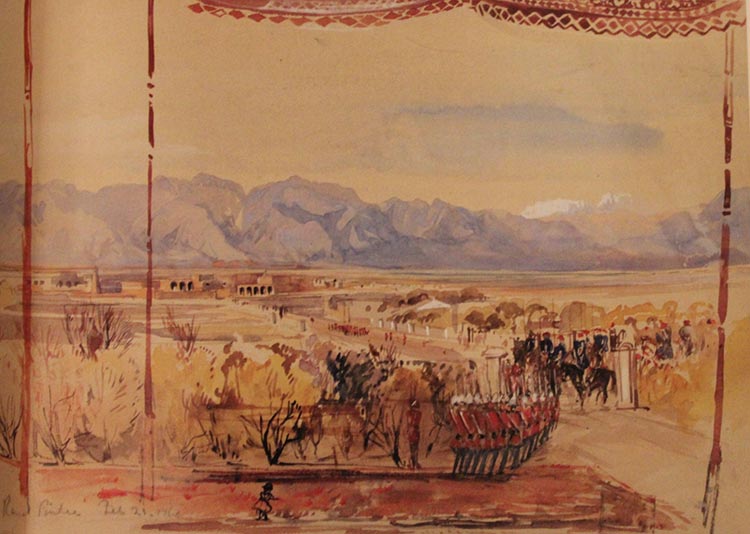
Written by: Aiman Javed
Posted on: November 23, 2018 |  | 中文
| 中文
Attock Fort, 2nd March, 1860
On Monday, 19th November, the book launch presentation of F.S. Aijazuddin’s latest work was conducted by the Asian Study Group (ASG) at Serena Hotel. Titled “Sketches from a Howdah,” the book is a compilation of watercolour paintings by Charlotte Lady Canning, the wife of the first Viceroy (1858-1862) of British India.
Ms. Perveen Malik, the President of ASG, introduced F.S. Aijazuddin and pointed out that ASG has hosted two of his previous presentations; “Punjab the Crucible of History” and “The Resourceful Fakirs.” Fakir Syed Aijazuddin is a remarkably prolific writer, with sixteen books to his credit, and experience as both a chartered accountant and an art historian. He happens to be an equally adept presenter, who introduced his work to the audience in a thoroughly charming manner.
Speaking on the occasion, the British High Commissioner H.E. Thomas Drew narrated a telling anecdote about the historian. In 2004, F.S. Aijazuddin acted as a tour guide for British Home Secretary David Blunkett, on his visit to Lahore. “Lord Blunkett is, as many of you know, blind, but few who witnessed it will forget Aijaz’s tour guiding skills when he showed him around Badshahi Mosque. Using the power of speech and touch alone, he painted a picture for David Blunkett that he has never forgotten,” Drew said.
Aijazuddin began his presentation with an introduction to Lady Canning’s life. She was born in 1817 in Paris, where her father was an Ambassador. At the age of eighteen, she fell in love and married the young Charles Canning. For the next thirteen years she remained Lady in Waiting to Her Majesty, Queen Victoria. During this time, she practiced her watercolours, since the Queen demanded that every scene they passed by should be painted. In 1856, she travelled from Britain to India with her husband, and took up residence in Calcutta.
Between 1858- 1861, she went on three tours of India and assiduously painted every place she visited. Her focus was primarily on landscapes, since she didn’t think she was skilled at figurative work. Interestingly, she would apply paint directly onto the paper, and didn’t draw on it beforehand. On her journeys, she usually used three modes of transport, i) a howdah atop an elephant, ii) riding on horseback, iii) a charabanc drawn by camels, which would allow her to sleep when needed.
Her first journey took her from Chennai to Coonoor, a hill station where she observed the beautiful scenery, as well as visited Tipu Sultan’s Summer Palace. She was so fascinated by the view at Tipu’s Drop, that the place is now known as Lady Canning’s seat.

For her next journey, she travelled to Bhopal, Agra, Delhi, Ambala, Amritsar, Lahore, Rawalpindi and Peshawer. She turned around at Khyber Pass, and on her way back, she stopped at Attock Fort and Rohtas Fort. She found Rohtas to be truly fascinating, and called it the “Ogre’s castle.” She then changed her route to visit the mountains. She went to Kangra, where the temple of Jawalamukhi fascinated her. Moving onto Chini, she finally ended up at the Kailash Peaks.
Her last journey took her to Central India, where she keenly painted the marble rock formations of Jabalpur. While Lord Canning went on a tiger hunt, she was busy capturing the waterfalls, rivers and hills. Soon after, she caught the “Purnea” fever and passed away at Barrackpore, on 19th November, 1861. She was buried at her favourite spot here, and her husband also passed away seven months later.
Taking the audience by surprise, Aijazuddin showed us a picture of Lady Canning’s grave. The picture was dated 19th November, 2018, and had been taken that very day by a friend of the author. On his request, his friend paid a poignant tribute to the lady, by visiting the grave, laying a wreath of flowers and distributing a mithai called ‘ladykeni’ (named after her) among the nuns at the church. “Even though she was a visitor, there was empathy for the country that she was living in, the people that she met, the scenery that she saw and it comes through in her paintings and in her narrative,” said the author.
To help the audience understand how the book was compiled over a period of two years, Aijazuddin discussed his three sources of information. Many of Lady Canning’s paintings belong to the Harewood family. Two years ago, the historian had the privilege of visiting Harewood House, Leeds, and examining these albums. They contained landscapes from her tours, as well as her natural history drawings. He came across a second group of paintings, which she had sent to her mother, at the Victoria and Albert Museum, London. The third group of paintings came from the Royal Library in Windsor, where the historian found the letters Lady Canning had sent to Queen Victoria. While it must have been a challenge to match each one of the paintings with her descriptions from her diaries, journals and letters, the historian seemed reasonably satisfied with his work.
With the conclusion of the presentation, the Indian High Commissioner H.E. Ajay Bisaria thanked Fakir Syed Aijazuddin for taking the audience on a wonderful journey. The author answered questions from the audience, and signed copies of his book.
You may also like: